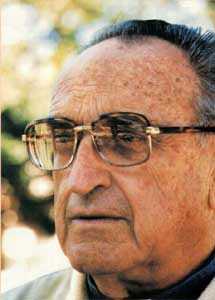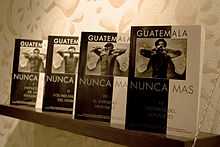Juan José Gerardi Conedera
| Juan José Gerardi Conedera | |
|---|---|
| Auxiliary Bishop of Diocese of Guatemala (Emeritus) | |
 | |
| Church | Roman Catholic Church |
| See | Archdiocese of Guatemala |
| In office | 1984 - 1998 |
| Successor | Mario Enrique Ríos Montt |
| Orders | |
| Ordination | 21 December 1946 |
| Personal details | |
| Born |
27 December 1922 Guatemala City, Guatemala |
| Died | April 26, 1998 (aged 75) |
| Previous post | Bishop of Santa Cruz del Quiché (1974-1984) |
Monsignor Juan José Gerardi Conedera (27 December 1922 – 26 April 1998)[1] was a Guatemalan Roman Catholic bishop and human rights defender who was long active in working with the indigenous Mayan peoples of the country. In the 1970s he gained government recognition of indigenous languages as official languages, and helped secure permission for radio stations to broadcast in indigenous languages. In 1988 he was appointed to the government's National Reconciliation Commission, to begin the process of accounting for abuses during the civil war.
He also worked on the associated Recovery of Historical Memory Project (REMHI) sponsored by the Catholic Church. Two days after he announced the release of its report on victims of the Guatemalan Civil War, Guatemala: Nunca Más!, in April 1998, Bishop Gerardi was attacked in his garage and beaten to death.[2] In 2001, in the first trial in a civilian court of members of the military in Guatemalan history, three Army officers were convicted of his death and sentenced to long prison terms. A priest was convicted as an accomplice and also sentenced.
Early life
Gerardi Conedera, of Italian ancestry, was born in Guatemala City on 27 December 1922. He studied at the city's seminary and won a scholarship to study theology in New Orleans, United States. On 21 December 1946, he was ordained a priest and served in several rural areas of Guatemala such as Mataquescuintla, San Pedro Sacatepéquez and Palencia, as well as in the capital city.
Bishop
On 9 May 1967, he was elected Bishop of Verapaz, assuming office the following 11 August. In this position, he emphasised pastoral work among indigenous communities of Mayan peoples.
In the 1970s during the country's on-going civil war, he was a strong proponent for the official recognition of Guatemala's indigenous languages, to improve the status of the indigenous peoples. He was instrumental in securing authorisation for two radio stations to broadcast in Mayan languages. In 1974, he was appointed Bishop of Quiché, but continued working as an Apostolic Administrator in Verapaz.
Between 1980 and 1983, El Quiché saw increased levels of violence in the conflict between the Army and various rebel guerrilla factions. Hundreds of Roman Catholic catechists and heads of Christian communities, most of whom were of Maya origin, were brutally murdered. Gerardi repeatedly asked the military authorities to control their actions.
While serving as president of the Guatemalan Conference of Bishops, Gerardi spoke out openly about the Spanish embassy fire of 31 January 1980, in which 39 people lost their lives. Guatemalan government forces were suspected of having sparked the fire.
That same year he was called to the Vatican to attend a synod. Upon returning to Guatemala, he was denied entry to the country because of his public criticism. He travelled to neighbouring El Salvador, which refused to grant him right of asylum. Gerardi settled temporarily in Costa Rica, where he remained until military president Romeo Lucas García was overthrown in 1982. The change in government allowed Gerardi to return to his dioceses in Guatemala.
On 28 August 1984, he was appointed auxiliary bishop of the Archdiocese of Guatemala.
National Reconciliation Commission
In 1988 the Conference of Bishops assigned Gerardi and Rodolfo Quezada Toruño to serve on the National Reconciliation Commission established by the government. This later led to the creation of the Office of Human Rights of the Archbishopric (Oficina de Derechos Humanos del Arzobispado, ODHA). It continues to provide assistance to victims of human rights violations.

In that context work began on the Recovery of Historical Memory (REMHI) project, to collect the facts and history of Guatemala's long civil war and confront the truth of those years. On 24 April 1998, REMHI presented the results of its work in the report Guatemala: Nunca más (Never again). This report summarized testimony and statements of thousands of witnesses and victims of repression during the Civil War. "The report laid the blame for 80 per cent of the atrocities at the door of the Guatemalan Army and its collaborators within the social and political elite."[3]
The task of historical recovery that Gerardi and his team pursued was fundamental in the subsequent work of the UN-sponsored Historical Clarification Commission (CEH). This was set up within the framework of the 1996 peace process, to bring out the facts about the period of the long government repression.
Some critics accused the Vatican, the REMHI and Gerardi of furthering Marxist propaganda because the REMHI blames the National Army for the vast majority of deaths during the civil war. The UN Truth Commission Report, released in February 1999, came to very similar conclusions as the REMHI report.
Assassination
On 26 April 1998, two days after the publication of Guatemala: Nunca más, Bishop Gerardi was attacked and bludgeoned to death in the garage of the parish house of San Sebastian Church, where he was the pastor.[3] His assailants used a concrete slab as the murder weapon. The bishop was so damaged in the brutal attack that his face was unrecognisable and identification of the corpse was made by means of his episcopal ring.
On 8 June 2001, three army officers: Colonel Byron Disrael Lima Estrada and Captain Byron Lima Oliva (who were father and son), and José Obdulio Villanueva, were convicted of Gerardi's murder and sentenced to 30-year prison terms. The priest Mario Orantes, whom the court had identified as an accomplice, was sentenced to 20 years.
The case was precedent-setting in that it was the first time that members of the military had been tried in a civilian court. The defendants appealed, and in March 2005 an appeals court lowered the Limas' sentences to 20 years each. Orantes' sentence was left unchanged. Villanueva had been killed in prison before the appeal verdict was reached. The Constitutional Court in April 2007 upheld the new sentences.
Lima Estrada, the father, had been trained at the School of the Americas.[4]
Maite Rico and Bertrand De La Grange in their ¿Quién mató al Obispo? ("Who Killed the Bishop?") suggested that the trial was related more to political gains than discovering the truth about the bishop's murder. The court had said that the investigation had to be carried up the chain of command in order to fully obtain all the information regarding the bishop’s death.
Notes
- ↑ Bishop Juan José Gerardi Conedera, catholic-hierarchy.org
- ↑ Archivo Histórico de la Policía Nacional (2013). From Silence to Memory: Revelations of the AHPN. Eugene, OR: University of Oregon Libraries. p. xl. ISBN 978-0-985-82041-1.
- ↑ 3.0 3.1 Stanford, Peter (16 March 2008), "Review of The Art of Political Murder: Who Killed Bishop Gerardi?, by Francisco Goldman", The Independent (London), retrieved 2008-04-10
- ↑ Monbiot, George (October 30, 2001). "Backyard terrorism". The Guardian (London).
See also
References
- "Monseñor Juan José Gerardi Conedera, 1922-1998: Mártir de la Paz", Conferencia Episcopal de Guatemala (in Spanish), retrieved 2008-04-10.
- "Monseñor Juan José Gerardi, 26 de abril de 1998, Guatemala", Cáritas Panamá, retrieved 2008-04-10.
- "Public Statement: Guatemala: Murder of Auxiliary Archbishop Juan Gerardi", Amnesty International, April 7, 1998, retrieved 2008-04-10.
- "Geradi case documents", Network in Solidarity with the People of Guatemala (NISGUA).
- Leahy, Patrick (April 28, 1998), "The Murder of Bishop Juan José Gerardi", Vermont's U.S. Senator, Patrick Leahy, retrieved 2008-04-10.
- Colonel Byron Disrael Lima Estrada: Alleged Mastermind behind the Murder of Bishop Juan Jose Gerardi Declassified Records from the U.S. Department of Defense
- "REMHI: Recovery of the Historic Memory", Foundation for Human Rights in Guatemala, retrieved 2008-04-10.
- Bishop Juan José Gerardi Conedera, catholic-hierarchy.org.
Further reading
- Goldman, Francisco (2007), The Art of Political Murder: Who Killed the Bishop?, New York: Grove Press, ISBN 978-0-8021-1828-8.